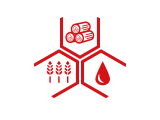Climate Change, Charcoal Trade and Armed Conflict in Somalia
Conceptual Model
Conflict history
Since the 1970s, charcoal has been one of Somalia’s principal exports, along with livestock, hides and bananas. Charcoal and firewood are the primary sources of energy for the majority of households in Somalia and charcoal production provides a considerable amount of employment in rural areas (Ismail, 2011; Mohamed, 2001). Despite several attempts to ban charcoal production because of its detrimental environmental effects, the industry has increasingly grown following the collapse of the Somalian state in the 1990s (Baxter, 2007; Gaworecki, 2015). The consequences for the environment are dramatic: Whereas forests represented about 13% of Somalia’s land area in 1990, they only covered about 10.7% in 2010, with signs for accelerating deforestation rates in recent years (Bolognesi et al., 2015; UNSC, 2011). But the growth of the industry has also provoked conflicts between woodcutters and rural communities, whose livelihoods are threatened by deforestation and soil erosion, and increased the revenues of armed groups such as al Shabaab (UNDP, 2013; UNSC, 2011). It has been estimated that al Shabaab earns USD 38-56 million annually from charcoal exports and USD 8-18 million annually from taxing charcoal traders at roadblocks and checkpoints. This makes charcoal one of the group’s main sources of income, but also a matter of conflict with rival rebel groups (Nellemann et al., 2014; UCDP, n.d.; Ward, 2014).
Illegal charcoal trade continues despite bans
Charcoal exports have been banned by successive Somalian administrations, including the current federal government. Yet, high demand for Somalian charcoal in the Gulf States, due to their strict laws on preventing local deforestation, acts as a strong incentive for Somalian traders to continue to export the country’s natural resources. This is further encouraged by the absence of effective government structures in Somalia, who could restrict the activities of woodcutters and charcoal traders (Baxter, 2007; Mohamed, 2012). Forest management and environmental protection is further hampered by unclear property rights regimes: communal land, which had been nationalised during the military regime of President Siad Barre (1969-1991) became de facto ‘ownerless’ after 1991 and has since been exploited by different communities and armed groups (Mohamed, 2001).
On the supply side, charcoal production has become an important source of income for rural populations affected by environmental hardship, displacement and conflict. Especially in the southern part of the country, increasingly frequent droughts and floods have combined with overgrazing, desertification and soil erosion to deplete pastoralist livelihoods. This dynamic is further accelerated by continuous fighting and mass displacements of rural populations. Left with little alternatives, more and more pastoralists turn to charcoal trading in order to survive, which further exacerbates local communities’ vulnerability to extreme weather events (Ismail, 2011; Mohamed, 2012).
A vicious cycle
Charcoal trading in Somalia does not only contribute to communal tensions and the military activities of rebel groups such as al Shabaab, it is also at the heart of a vicious cycle of environmental degradation, depleted livelihoods and further deforestation, accelerated by and exacerbating the local impacts of climate change. In order to tackle these issues, the federal government, the UN Security Council (UNSC) and other organisation are not only trying to restrict charcoal exports from Somalia, but also to reduce local charcoal consumption and promote alternative livelihoods.
Conflict resolution
Alarming deforestation rates in connection with charcoal production already led to the ban of charcoal exports under the Siad Barre regime, as well as under the rule of General Mohamed Farah Aidid, who exerted control over much of southern Somalia from 1992 to 1996. However, General Aidid’s son and successor, Hussein Mohamed Aidid, did not impose such restriction, leading to an increase of charcoal production after 1996. The ban was re-imposed in 2000 and has been in effect since then, albeit poorly enforced, under changing transitional administrations. In 2010, the Transitional Federal Government of Somalia succeeded in diminishing charcoal exports from a number of ports, including Mogadishu and Marka, but the trade continued unabated in ports controlled by al Shabaab, such as Kismayo (Baxter, 2007; UNSC, 2011; White, 2019).
Actions against illegal charcoal exports
In 2012, the UN took note of the charcoal trade and its ramifications with the military operations of al Shabaab. The UNSC issued Resolution 2036, urging UN member states, presumably the Gulf States through which the charcoal trade flows, to take the necessary measures to prevent the import of charcoal from Somalia. The same year, Somalian and African Union troops were able to re-capture Kismayo. Yet, according to a group of UN monitors, Somalia’s illegal charcoal trade and corruption have continued unabated, securing a steady income for al Shabaab (UNEP, 2018; UNSC, 2014). In 2014, the UNSC issued Resolution 2182, which authorises the naval inspection of ships bound for Somalia in its territorial waters and on the high seas, including the Arabian Sea and the Persian Gulf (Keatinge, 2014; Yoon & Gridneff, 2014). The success of this measure has yet to be evaluated.
Reducing charcoal consumption and promoting alternative livelihoods
Efforts to ban charcoal exports have been accompanied by programmes aiming at reducing charcoal consumption and promoting alternative livelihoods. UNEP, UNDP and FAO support the Somalian government in a programme led by the Ministry of Natural Resources to enhance regional cooperation, establish regulatory instruments and enforcement mechanisms, introduce alternative sources of energy, and most importantly, help charcoal producers and traders to find alternative livelihoods (UNEP, 2019). It is estimated that the adoption of more efficient stoves and kilns for charcoal production could result in a total 50% decline in charcoal consumption and 80% decline in woodcutting (UNDP, 2013). These programmes are complemented by the work of numerous grassroots initiatives in the domains of environmental protection, awareness raising and promotion of sustainable livelihoods. Among these, Fatima Jibrell, a female Somalian environmentalist, recently rose to prominence by winning the 2014 UNEP’s Champion of the Earth award for her continuous fight against illegal charcoal trade in Somalia (Hiiraan, 2014).
However, in the short- to medium-term, charcoal production remains a key source of energy for many Somalis. Hence, while the search for alternative livelihood strategies continues, efforts should in the meantime also look into sustainable charcoal production and replanting for the internal market, perhaps drawing on lessons learnt from Sudan (Middleton et al., 2018).
Remaining challenges
Despite these efforts to curtail the sources of rebel finance and promote sustainable livelihoods in Somalia, major challenges still remain. The effects of Resolution 2182 have yet to materialise. Controlling the inland trade is also difficult. Different sources have revealed the implication of the Kenyan contingent of the African Union Mission in Somalia (AMISOM) in the illegal charcoal trade and profit-sharing agreements with al Shabaab (allAfrica, 2014; Middleton et al., 2018; Ward, 2014). Most importantly, Somalia has been lacking a comprehensive framework for environmental protection, resource governance and drought preparedness for many years. Corresponding legislations need revision and more effective enforcement. The ambitious charcoal use reduction programme of the Somalian government and its partners is set to change this. It remains to be seen in how far it will succeed.
Resilience and Peace Building
Promoting alternative livelihoods
Various international organisations as well as grassroots initiatives have worked to reduce charcoal consumption and promote alternative livelihoods for charcoal producers.
Strengthening legislation and law enforcement
After a charcoal ban was imposed in 2000, the Transitional Federal Government of Somalia succeeded in diminishing charcoal exports from a number of ports after 2010. However, trade continued unabated in ports controlled by al Shabaab. The UNSC issued resolutions urging Gulf States to prevent the import of charcoal from Somalia, and authorised the naval inspection of ships bound for the country.
Coping with uncertainty
A comprehensive framework for environmental protection, resource governance and drought preparedness would help address socio-environmental challenges in Somalia.
Resources and Materials
- allAfrica (2014). Somalia: Al-Shabaab Generates Millions of Revenue From Kismayo Charcoal Exports.
- Baxter, Z. (2007). Somalia’s Coal Industry. ICE Case Studies No. 201.
- Bolognesi, M. et al. (2015). Rapid mapping and impact estimation of illegal charcoal production in southern Somalia based on WorldView-1 imagery. Energy for Sustainable Development, 25, 40-49.
- Gaworecki, M. (2015). Somali charcoal: funding terrorism through deforestation. Mongabay.
- Hiiraan (2014). Somali conservationist bags UNEP's Champion of the Earth Award. Hiiraan Online.
- Ismail, S. (2011). Charcoal Trade Stripping Somalia of Trees: Deforestation Contributing Factor to Famine, Say Experts. Somalia Report.
- Keatinge, T. (2014). Black Market: How the Charcoal Trade Fuels al Shabab. Foreign Affairs.
- Middleton, R. et al. (2018). Somalia. Climate-related security risk assessment. Expert Working Group on Climate-related Security Risks.
- Mohamed, A. (2012). Charcoal Enterprise in Somalia: Disaster in the Making. Somalia Report.
- Mohamed, A.E. (2001). Somalia’s Degrading Environment: Causes and Effects of Deforestation and Hazardous Waste Dumping in Somalia. Essay. Somalia Centre for Water & Environment.
- Nellemann, C. et al. (2014). The environmental crime crisis: Threats to sustainable development from illegal exploitation and trade in wildlife and forest resources. A UNEP Rapid Response Assessment. Nairobi and Arendal: UNEP and GRID-Arendal.
- UCDP (n.d,). Somalia. UCDP Conflict Encyclopedia.
- UNDP (2013). Breaking the cycle of charcoal production in Somalia.
- UNEP (2018). How Somalia’s charcoal trade is fuelling the Acacia’s demise. UNEP Story.
- UNEP (2019). Programme for Sustainable Charcoal Reduction and Alternative Livelihoods (PROSCAL). Factsheet.
- UNSC (2011). Report of the Secretary-General on the protection of Somali natural resources and waters. S/2011/661.
- UNSC (2014). Letter dated 10 October 2014 from the Chair of the Security Council Committee pursuant to resolutions 751 (1992) and 1907 (2009) concerning Somalia and Eritrea addressed to the President of the Security Council. S/2014/726.
- Ward, G.F. (2014). The Somali charcoal industry: Strange bedfellows. Africa Watch. Alexandria, VA: IDA.
- White, E. (2019). The unintended consequences of charcoal. The Strategist.
- Yoon, S. & Gridneff, I (2014). UN orders ship searches to find Al-Shabaab’s charcoal. Bloomberg.


